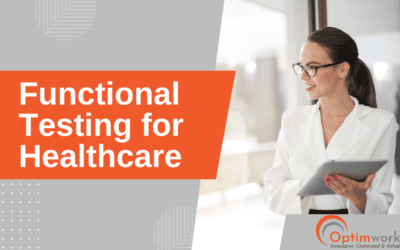In today’s digital world, users expect eCommerce apps to work from the very first tap. Whether it’s browsing products, adding to cart, or making a payment—every interaction has to work. That’s why having a strong mobile functional testing checklist for eCommerce apps is essential. A small bug or checkout error isn’t just a bug—it’s a lost sale and possibly a lost customer.
This blog offers a comprehensive yet practical mobile functional testing checklist specifically for eCommerce apps—and how Optimworks can help ensure your app performs smoothly, scales efficiently, and converts reliably.
We’ll also show you how Optimworks brings structure, speed, and ROI to this process with our proven QA framework.
Why Functional Testing Is Non-Negotiable for eCommerce Apps
If your app has even one broken interaction in the buyer journey—whether it’s login, product search, or checkout—it creates friction. And friction kills conversions.
Think about it:
- A customer adds items to the cart. But the cart resets on app refresh.
- A promo code fails during checkout. The user abandons the purchase.
- A payment gateway works on Android but fails silently on iOS.
These aren’t hypothetical issues. These are real, frequent bugs we’ve seen in major eCommerce apps before testing. And they cost brands millions in missed sales and wasted marketing spend.
That’s why functional testing should never be “nice to have.” It’s mission-critical.
The Ultimate Mobile Functional Testing Checklist for eCommerce Apps
This checklist is designed for QA leads and product managers preparing for release or regression cycles. It covers what matters most—across both iOS and Android environments.
- Onboarding & Login
- Ensure email, phone, and social logins work correctly
- Validate OTP-based authentication and password reset flows
- Test first-time user tutorials or intro screens for glitches
- Product Discovery
- Check search bar functionality with multiple keywords
- Test filters and sorting across all categories
- Validate product loading on scroll or pagination
- Product Page Integrity
- Verify image zoom, carousel swipe, and video previews
- Ensure product options (size, color, etc.) select and reflect correctly
- Test reviews, ratings, and availability displays
- Add to Cart & Checkout
- Test cart updates, quantity edits, and product removals
- Validate multiple payment gateways (UPI, cards, wallets)
- Apply discount codes and check price recalculations
- Test address autofill, selection, and saving features
- Order Summary & Confirmation
- Ensure summary page reflects all updates accurately
- Confirm correct tax, shipping, and discount calculations
- Validate order placement, confirmation screens, and emails
- Post-Purchase Flows
- Test cancellation, return, and refund journeys
- Check order tracking and delivery status updates
- Validate feedback submission and customer support options
- Network & Device Handling
- Test app behavior on airplane mode and poor connections
- Validate compatibility on major Android/iOS devices and OS versions
- Check UI rendering on different screen sizes
- Security & Compliance Basics
- Validate secure data transmission (SSL, HTTPS)
- Ensure sensitive data isn’t visible in logs or in plain text
- Test login session expiration and reauthentication logic
These are not just boxes to tick. These are points of failure that impact your NPS score, conversion rate, and app store rating.
Want a second pair of eyes on your mobile QA?
Optimworks offers pilot testing for eCommerce apps, helping you uncover missed bugs before they reach users. No commitment needed—just insights that help you move faster and smarter.
What Most Teams Miss During Functional Testing
Even seasoned teams overlook these:
- Session persistence: Does the cart remain after login/logout?
- Mid-flow address changes: What happens if I edit my delivery address after placing an order?
- Device sync: Cart added in iOS, but doesn’t reflect in Android?
- Language & currency toggles: Do localized labels render correctly?
These “edge cases” cause some of the worst bugs because they’re usually untested. Optimworks tests these as standard—because real users do unpredictable things.
How Optimworks Delivers Bug-Free Mobile E-com Apps
Testing a mobile eCommerce app isn’t just about running test cases. It’s about replicating real-world user behavior under different devices, networks, and edge conditions. That’s what Optimworks does better.
Here’s how:
1. Proven Experience in eCommerce QA
From global fashion apps to fast-growing grocery delivery platforms—we’ve tested it all. Our QA team brings domain knowledge, not just generic checklists.
We know what typically breaks, what frustrates users, and what silently leaks revenue.
2. Cross-Device Real Testing
We don’t rely only on emulators. We test across real Android and iOS devices covering low-end to flagship models, because user experiences vary by hardware.
3. Tool-Agnostic Test Automation
Whether your team uses Appium, BrowserStack, TestProject, or in-house tools—our engineers plug right into your ecosystem without forcing platform changes.
We automate what’s repetitive, so manual testers can focus on UX-critical paths.
4. “Pilot-as-Proof” QA Engagement
Not sure we’re the right fit? Start with a free pilot. We’ll run a 2–3 day test sprint on your mobile app and show you a detailed report of functional gaps, UX bugs, and improvement areas.
If we deliver value, you scale with us. If not, you still get expert feedback. Zero risk.
5. Optimworks IOR Framework
Our testing isn’t just fast—it’s built on our proprietary IOR QA Model:
- Innovative methods (like visual diff detection for UI regressions)
- Optimized test cycles (based on your sprint cadence)
- Reliable delivery (because we know how high the stakes are)
A Real-World Case Studies
An eCommerce fashion brand came to us with high cart abandonment on their mobile app. Within one sprint, Optimworks identified 23 critical bugs—including a promo code edge case, misaligned checkout CTA, and a crash on international payments. After fixes, their checkout success rate improved by 45%.
That’s the impact of QA done right.
Conclusion
Functional issues are silent killers of growth. They may not be obvious at first, but over time, they erode user trust and revenue. A strong mobile functional testing strategy is no longer optional—it’s essential.
Use the checklist above as your QA baseline. But if you want to go faster, more confidently, and catch bugs before they reach production—Optimworks is here to help.
Let’s build something better together. Get in touch with our team and explore a risk-free pilot test for your mobile eCommerce app today.
Ready to Build a Mobile App That Doesn’t Break?
If you’re preparing for your next app release, running A/B tests, or planning a feature launch—you need a mobile QA strategy that’s more than checklists. You need real testing. At speed. With measurable ROI. Contact Us Today
Mobile Functional Testing Checklist FAQs
Q1. What is eCommerce mobile app testing and why is it important?
eCommerce mobile app testing is the process of validating every feature and workflow of a shopping application before customers use it. One checkout glitch or payment integration fail and you lose sales and trust. At Optimworks we test your eCommerce apps across devices, platforms and network conditions so customers get a smooth, secure experience every time.
Q2. What should be included in an app testing checklist?
A good app testing checklist covers everything. This includes functional testing (search, cart, checkout), usability testing (UI/UX flows), performance testing (speed under load), security testing and cross device testing. Optimworks builds custom mobile app testing checklists for eCommerce clients so you don’t miss anything and can release faster without compromising quality.
Q3. How does a mobile testing checklist improve app quality?
A mobile testing checklist brings structure and consistency to the QA process. Instead of relying on ad-hoc testing, Optimworks’ structured approach ensures critical flows—login, payments, push notifications, and order tracking—are verified in every cycle. This reduces defects in production, lowers rework costs, and helps eCommerce brands deliver smooth, conversion-focused apps.
Q4. What is the best checklist for mobile app testing in eCommerce?
The best checklist for mobile app testing in eCommerce prioritizes business-critical workflows such as cart, payments, refunds, peak-load performance, API integrations, and compliance with PCI-DSS or GDPR. At Optimworks, we’ve designed BFSI-grade testing frameworks and applied them to eCommerce, ensuring apps handle high-volume transactions securely while providing an intuitive customer experience. Our checklists are tailored, not generic—built to help you launch with confidence.




